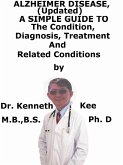I first came across a rare case of Gaucher Disease in a small boy in Singapore and the parents told me that they are paying U$35,000 for each treatment given. I was shocked by the cost.
Gaucher disease (also called Gaucher's disease) is an inherited (genetic) disorder that cause the abnormal collection of fatty substances called glycolipids in different body tissues due to a deficiency of an enzyme termed glucocerebrosidase.
Gaucher disease is due to a genetic defect in a gene known as GBA1.
Gaucher disease is part of a class of diseases called lysosomal storage diseases, called after a type of cell that is involved by the buildup of glycolipids.
Inheritance
Gaucher disease is inherited in an autosomal recessive pattern, meaning that both parents must have a copy of the defective gene in order for a child to be affected.
There are several types of Gaucher disease such as type 1, 2, 3 Gaucher disease; perinatal lethal Gaucher disease, and cardiovascular Gaucher disease.
The most frequent type of Gaucher disease is type 1, and this type normally does not involve the nervous system.
Type 2 Gaucher disease and perinatal lethal Gaucher disease are rare and severe forms of the disease.
1.Type 1 Gaucher disease is the most frequent form of the disorder
About 90% of people with the disorder have this type.
The signs and symptoms of this type can differ in their extent of severity.
The symptoms can happen in childhood or may be postponed until adulthood.
The brain and spinal cord, or central nervous system (CNS), are normally not involved by the disease, so this type is occasionally referred to as non-neuronopathic, meaning that the disorder does not involve nerve cells.
2.Type 2 Gaucher disease involves the nervous system and is called neuronopathic Gaucher disease.
Signs and symptoms are seizures, eye movement disorders, and brain damage.
Type 2 Gaucher disease is very serious and normally causes life-threatening medical disorders that start in infancy.
3.Type 3 Gaucher disease (chronic neuronopathic form) is a neuronopathic form of Gaucher disease that involves the nervous system, but symptoms do not progress as fast as in Type 2.
The signs and symptoms may happen in infancy or later in childhood.
4.Perinatal lethal Gaucher disease is the most serious form of the disorder.
With this type, the life-threatening disorders can happen before birth.
There may be excess swelling and fluid collection in the fetus (hydrops fetalis) before birth.
Other features can be serious neurological disturbances, abnormal facial features, hepatosplenomegaly and dry or scaly skin.
Most infants with this form of the disorder live only a few days after birth.
5.Cardiovascular Gaucher disease, regarded a rare subgroup of type 3 disease, mainly involves the heart, causing calcification or hardening of the heart valves.
All of the types of Gaucher disease are produced by a deficiency of the enzyme glucocerebrosidase, resulting in an abnormal collection of fatty substances, glycolipids, in the body cells.
Mutations in the gene called GBA1 are the source of the deficient enzyme, and over 300 different GBA1 mutations have been recognized in people with Gaucher disease.
Diagnosis
The enzyme assay test determines the activity of the glucocerebrosidase enzyme in certain white blood cells.
The presence of less than 15% of normal enzyme activity is diagnostic for Gaucher disease.
Genetic analysis is also done to verify the specific type of mutations in the
Treatment
There is no cure for Gaucher disease
Enzyme replacement therapy (ERT) is the main form of treatment for people with type 1 Gaucher disease.
TABLE OF CONTENT
Introduction
Chapter 1 Gaucher Disease
Chapter 2 Causes
Chapter 3 Symptoms
Chapter 4 D...
Dieser Download kann aus rechtlichen Gründen nur mit Rechnungsadresse in A, B, CY, CZ, D, DK, EW, E, FIN, F, GR, H, IRL, I, LT, L, LR, M, NL, PL, P, R, S, SLO, SK ausgeliefert werden.









